Keeping up with medical technology feels impossible. New displays with new features emerge constantly, making current equipment seem outdated and complicating purchasing decisions. Understanding this evolution is key.
The rapid pace of technological change impacts everything from resolution and AI integration to hospital procurement cycles. These advancements also affect regulatory processes and the competitive market landscape.
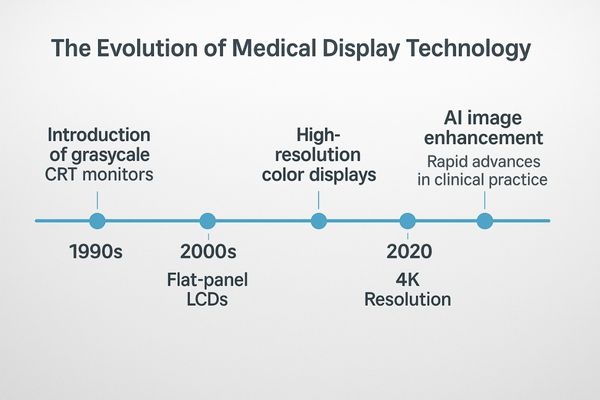
The world of medical displays1 is not static. It is in a state of constant and rapid evolution. What was considered state-of-the-art just a few years ago is now standard, and today’s cutting-edge features will soon be baseline expectations. This relentless pace of innovation brings incredible benefits to patient care2 by providing clinicians with ever-clearer and more intelligent tools. However, it also creates significant challenges for healthcare providers who must plan budgets, navigate regulations, and make long-term investment decisions. We will now explore the key drivers and consequences of this rapid technological iteration.
Rapid Advancements in Resolution and Color Accuracy
Are your displays showing the complete clinical picture? Today’s resolution standards are advancing so quickly that a recently purchased monitor can become a diagnostic weak link sooner than expected.
Medical display resolutions have leapt from 2MP to 12MP in just a few years. Corresponding improvements in color and grayscale accuracy are continuously redefining clinical benchmarks and expectations.
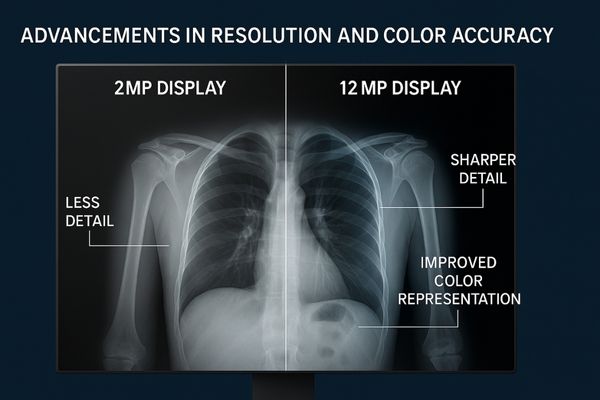
The most visible sign of technological iteration is the race for higher resolution. Just over a decade ago, a 2-megapixel (2MP) display was the standard for general radiology. Today, 5MP displays are required for mammography, while 8MP and 12MP multi-modality monitors are becoming common for complex diagnostic workstations. This increase in pixel density allows clinicians to see finer anatomical details without the need for excessive panning and zooming, improving efficiency and reducing the risk of missing subtle pathologies. Alongside resolution, color and grayscale performance have also advanced significantly. Modern displays have wider color gamuts for pathology3 and surgery. They also offer greater bit depth for more precise grayscale rendering in radiology. This allows for the differentiation of thousands of shades of gray, which is critical for interpreting low-contrast images. Products like the MD120C – 12MP High-Precision Diagnostic Monitor4 with AI Calibration embody this trend, combining ultra-high resolution with sophisticated calibration to meet the most demanding clinical needs.
| Resolution | Primary Clinical Application | Key Benefit |
|---|---|---|
| 2MP – 3MP | General Radiology (CT, MR), PACS Review | Standard clarity for routine case review. |
| 5MP | Digital Mammography, Tomosynthesis | Required for detecting microcalcifications. |
| 8MP – 12MP | Multi-modality Fusion (PET/CT), Chest X-ray | Enables simultaneous viewing of large, complex images. |
Integration of AI and Automation Accelerates Display Evolution
Manual calibration and quality assurance checks consume valuable time. Displays are becoming smarter, but integrating them presents a new set of opportunities. AI-driven automation is the next major step.
AI-powered features like automated calibration and real-time image optimization are accelerating display evolution. These advancements are transforming monitors from passive viewing tools into intelligent clinical assistants.
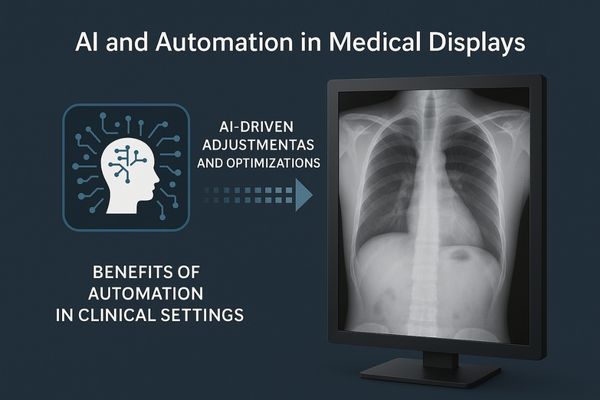
The next frontier of display technology is not just about better pixels; it is about smarter pixels. The integration of artificial intelligence5 and automation is fundamentally changing what a medical display can do. Traditionally, maintaining a monitor’s performance required manual calibration and quality assurance (QA) procedures performed by a medical physicist or IT staff. Today, advanced displays are becoming self-managing. They use built-in sensors and AI-driven algorithms to perform automated DICOM compliance checks6, adjust brightness based on ambient light conditions, and even compensate for the natural aging of the backlight. These features reduce the manual workload on hospital staff, minimize human error, and ensure the display is always performing at its peak. This transforms the monitor from a passive device that simply shows an image into an active partner in the diagnostic process. The MD85CA, with its optional AI-assisted gamma settings, is an example of this shift toward more intelligent and autonomous hardware.
Shorter Product Cycles Challenge Hospital Procurement Plans
Did your hospital just complete a major equipment upgrade? The underlying technology has likely already evolved, creating a planning dilemma for your next budget cycle. This rapid pace requires new thinking.
The fast pace of innovation shortens product lifecycles from years to months. This creates unprecedented challenges for hospital procurement teams trying to manage long-term budget plans and technology roadmaps.
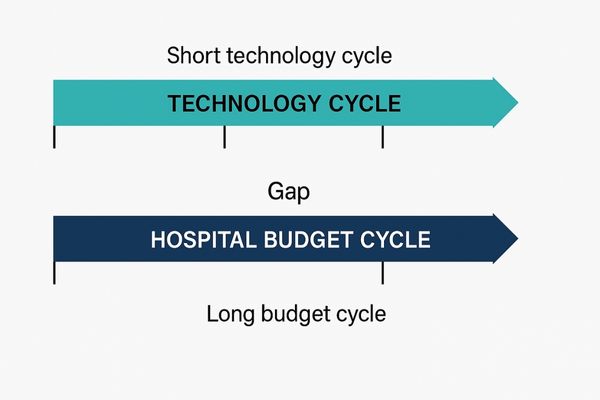
Hospitals traditionally operate on long-term procurement cycles, often planning major capital expenditures three to seven years in advance. This model works well for durable equipment with a slow pace of change. However, it is increasingly out of sync with the rapid iteration of display technology, where a product line might be refreshed every 18 to 24 months. This mismatch creates a significant challenge. A hospital might approve a budget for a fleet of 4K surgical displays7, but by the time the funds are released and the purchase order is placed, a newer model with improved features may already be available. This forces procurement departments into a difficult choice: buy the approved but slightly dated technology, or restart the lengthy justification and approval process for the newer model. This dynamic pressures hospitals to adopt more flexible and forward-looking procurement strategies. It also highlights the importance of choosing durable, high-performance assets8 like the MS321PB – 32" 4K Surgical Monitor, which can provide excellent clinical value across a longer service life.
| Factor | Hospital Procurement Cycle | Technology Iteration Cycle |
|---|---|---|
| Timeline | 3-7 years | 1.5-2 years |
| Primary Driver | Budgetary planning, established need | R&D, market competition |
| Challenge | Risk of buying outdated technology. | Pressure to demonstrate clear value. |
| Solution | Flexible budgeting, focus on TCO. | Backward compatibility, modular design. |
Regulatory Adaptation Lags Behind Technological Growth
Have you identified the perfect new display for your clinical needs? Getting it approved for purchase can be a slow process because regulations often move slower than innovation. This lag creates a bottleneck.
The development of new display technologies frequently outpaces updates to the corresponding regulatory standards. This lag can extend certification and validation timelines, delaying the adoption of new clinical tools.
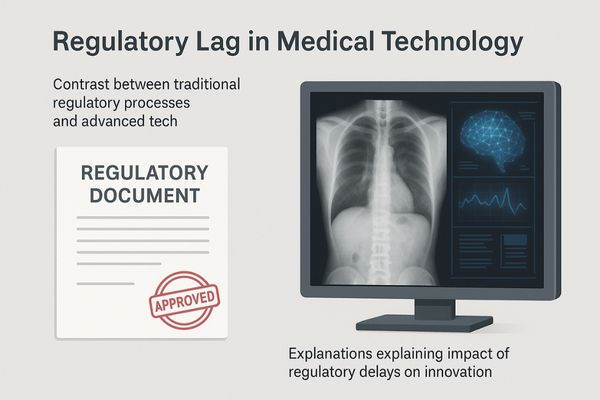
Before any medical device can be sold, it must undergo a rigorous certification process to demonstrate its safety and effectiveness. In Europe, this involves obtaining a CE mark under the Medical Device Regulation (MDR)9, while in the United States, it requires clearance from the Food and Drug Administration (FDA)10. This process is thorough and essential, but it is not always fast. When a truly novel technology emerges, such as a new type of AI-based diagnostic aid, there may not be a pre-existing regulatory framework to evaluate it against. Regulators must take time to understand the technology and develop appropriate testing standards. This creates an unavoidable lag where innovation gets ahead of regulation. For manufacturers, this means a longer and more complex path to market for their most advanced products. For hospitals, it can mean a delay in accessing the latest tools. This is why a proven compliance record is so important, showing that a manufacturer understands and can navigate this complex landscape, as demonstrated by certified products like the MS270P – 27" FHD Surgical Display.
Continuous Innovation Reshapes Competitive Market Landscape
Is your organization’s go-to brand still the best choice? The medical display market is in constant flux, with new competitors and technologies changing the old dynamics. Staying informed is crucial for making the best choice.
Continuous technological innovation is intensifying competition within the medical display market. This dynamic environment reshapes the industry landscape and forces all companies to accelerate their research and development investments.
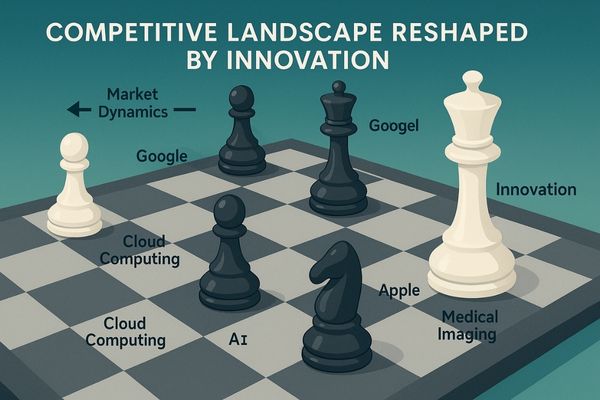
The rapid speed of innovation acts as a powerful force on the competitive market. It creates both opportunities and threats for all manufacturers. On one hand, new technologies can lower the barrier to entry in some segments, allowing new players to challenge established leaders. On the other hand, the high cost of R&D11 required to develop next-generation products, like panels with extremely high resolutions or complex AI algorithms, raises the barrier to entry in the high-end market. This environment forces companies to make strategic choices12. Some may choose to compete on volume and price, while others focus on specialized, high-performance niches. The basis of competition is also shifting from being purely hardware-focused to including software, service, and ecosystem integration. Innovation in form factor, such as creating a single large panel to replace two smaller monitors, is another way companies differentiate. The MD46C – Dual-screen Diagnostic Monitor (Single Panel) is a perfect example of this, offering a unique solution that directly addresses a specific clinical workflow challenge and reshapes user expectations.
Conclusion
The rapid iteration of medical display technology offers immense clinical benefits but requires a new strategic approach from healthcare providers to manage procurement and stay current with the latest advancements.
📩 Need help navigating fast-evolving display technologies for your hospital? Contact Martin at martin@reshinmonitors.com for tailored insights and solutions from Reshin.
-
Explore this link to understand how medical displays are evolving and their impact on patient care. ↩
-
Discover insights on how advancements in technology enhance patient care and outcomes. ↩
-
Learn about the importance of color gamuts in accurately interpreting medical images and enhancing patient care. ↩
-
Explore how a 12MP monitor enhances diagnostic accuracy and efficiency in clinical settings. ↩
-
Explore how AI is revolutionizing medical displays, enhancing performance and efficiency in healthcare. ↩
-
Learn about the benefits of automated DICOM compliance checks in ensuring high-quality medical imaging. ↩
-
Explore this link to understand how 4K surgical displays enhance surgical precision and improve patient outcomes. ↩
-
Learn why investing in durable, high-performance assets is crucial for hospitals to ensure long-term value and efficiency. ↩
-
Understanding the MDR is crucial for anyone involved in medical device manufacturing or regulation, ensuring compliance and safety. ↩
-
Exploring the FDA’s role provides insights into the regulatory process, essential for manufacturers and healthcare professionals. ↩
-
Understanding the implications of R&D costs can help businesses strategize effectively in a competitive market. ↩
-
Exploring strategic choices can provide insights into how companies navigate challenges and leverage opportunities in their industries. ↩


